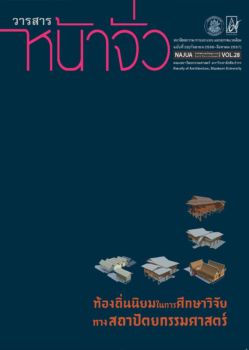เมืองแม่แจ่ม: ภูมิปัญญาล้านนาในการตั้งถิ่นฐาน
Keywords:
ภูมิปัญญาล้านนา, การตั้งถิ่นฐาน, โครงสร้างเมือง, องค์ประกอบเมือง, Lanna Wisdom, Urban Settlement, Urban Structure, Urban ElementsAbstract
บทความ “เมืองแม่แจ่ม: ภูมิปัญญาล้านนาในการตั้งถิ่นฐาน” เป็นส่วนหนึ่งของงานวิจัยในหัวข้อ “การศึกษารูปแบบและวิธีการจัดทำชุดความรู้เรื่องที่อยู่อาศัยและวิถีการอยู่อาศัย กรณีศึกษา: อำเภอแม่แจ่ม จังหวัดเชียงใหม่” ที่ได้รับทุนสนับสนุนการวิจัยจากการเคหะแห่งชาติบทความนี้ ได้มุ่งศึกษาในประเด็นเรื่องการตั้งถิ่นฐานของเมืองในพื้นที่หุบเขาที่แสดงออกถึงภูมิปัญญาล้านนาโดยให้ความสำคัญกับมิติทางกายภาพของโครงสร้างเมืองที่สัมพันธ์กับภูมิประเทศและสภาพแวดล้อม คติความเชื่อเรื่องผีและพุทธศาสนาที่มีผลต่อการกำหนดโครงสร้าง องค์ประกอบเมือง และหมู่บ้าน วิถีชีวิตใน สังคมเกษตรกรรมของเมืองขนาดเล็กที่มีการผลิตแบบพอยังชีพ ทำให้เมืองแม่แจ่มงดงาม มีชีวิตชีวาและเป็น ภาพสะท้อนวิถีวัฒนธรรมล้านนา ข้อมูลในบทความนี้มาจากการศึกษาเอกสารที่เกี่ยวข้อง การศึกษาแผนที่และภาพถ่ายทางอากาศ การสำรวจภาคสนาม
ผลการศึกษาพบว่า ภูมิปัญญาในการตั้งถิ่นฐานของเมืองแม่แจ่มสัมพันธ์กับปัจจัยทางกายภาพตามลักษณะภูมิประเทศในพื้นที่หุบเขาบนที่ราบแคบยาว มีนํ้าแม่แจ่มไหลผ่าน ภูมิอากาศหนาวเย็น ฝนตกชุก สัมพันธ์กับปัจจัยทางเศรษฐกิจเพื่อให้มีข้าวซึ่งเป็นอาหารหลักกินได้ตลอดปีจึงใช้ที่ราบลุ่มนํ้าที่มีอยู่จำกัดเป็น ผืนนา และขยายขึ้นไปบนเชิงเขาเกิดเป็นนาขั้นบันไดที่ต้องจัดการระบบเหมืองฝาย เพื่อใช้ในการเพาะปลูก รวมทั้งชะลอนํ้าไม่ให้หลากท่วมบ้านเมือง เพราะ “นํ้าเหนือ” มีปริมาณมากและไหลแรงตามความลาดชันของพื้นที่ ดังนั้นบริเวณที่เหมาะสมต่อการตั้งถิ่นฐานจึงใช้ที่สันพนังธรรมชาติและที่เชิงดอยที่นํ้าท่วมไม่ถึงเป็นที่ตั้งบ้านเรือน เกิดเป็นลักษณะเฉพาะใน 2 รูปแบบ คือ “บ้านสัน” และ “บ้านเชิงดอย” สัมพันธ์กับปัจจัยทางสังคมโดยเฉพาะ คติความเชื่อ “ผีควบเมือง” โดยมีนัยยะการกำหนดที่ตั้งตามแหล่งทรัพยากรธรรมชาติที่ให้คุณกับชีวิต ได้แก่ ผืนป่า นํ้า และที่ราบ ส่วนหมู่บ้านก็มี “หอเสื้อบ้าน” ในดงไม้ใหญ่ กำหนดให้วัดช่างเคิ่งเป็น “วัดหลวง” บนที่สันผืน ใหญ่ที่สุดของ “บ้านหลวง” ซึ่งต่อมาพัฒนาเป็นศูนย์ราชการและย่านการค้า บรรยากาศในหมู่บ้านจะพบเห็น วัดประจำหมู่บ้าน เรือนไม้แบบประเพณีหรือ “เฮือนบะเก่า” แวดล้อมด้วยพืชผักสวนครัว สวนกล้วย สวนหมาก สวนผลไม้ที่ร่มรื่น ถัดออกไปจึงเป็นไร่นา และภูเขาที่โอบล้อมเมืองแม่แจ่มไว้ให้อยู่ในวิถีวัฒนธรรมเดียวกัน
Maechaem: The Lanna Wisdom of Urban Settlement
Isara Guntang, Lecturer
Faculty of Art and Architecture
Rajamankala University of Technology Lanna
This article “Maechaem: The Lanna Wisdom of Urban Settlement” is part of the study entitled “Study on the Model and Method for Knowledge Management on Habitat and Habitation, A Case Study: Maechaem District, Chiang Mai Province” funded by The National Housing Authority.
The article focused on studying the urban settlement in the valley area that reflected the Lanna wisdom by giving significance to the physical dimension of the urban structures in relation to the topography and the environment as well as the animistic beliefs and Buddhism which affected the structure and other elements of the city and villages. The lifestyle of the agrarian society of a small town with sustainable production makes Maechaem a beautiful and lively town of Lanna culture. Information and data in this article were derived from relevant documents, maps and aerial photos together with a field survey.
The study found that the wisdom of the urban settlement of Maechaem was related to physical elements of the topography in the valley on the narrow plain along the Mae Chaem River which had a cold climate and a lot of rain. This was also related to economic factors. In order to have enough rice as a staple food all year round, the limited river plain was used for paddy rice fields, which extended further up the foot of the hill to create a terrace style farmland that depended on the old irrigation system known as mueang fai to prevent the city from flooding and to direct a large amount and rapid flow of water down the steep areas. Thus, the suitable area for urban settlement was one that had some natural contours or walls and area at the foot of the hill where floods could not reach. This resulted in two models of settlement, one with natural walls called “Ban San” and one on the foot of the hill called “Ban Choeng Doi”. This was related to social factors, in particular their beliefs about guardian spirits or “Phi khuap mueang” where an area was chosen for a settlement due to its being rich with natural resources useful for a living such as a forest, water and a plains area. The village itself has a spirit shrine called “Ho Suea Ban” in a woodland and a temple named Chan Khoeng as the main temple or “Wat Luang” located on the largest piece of land with a natural wall (san) of the “Ban Luang” which later became an administration and business area. The atmosphere of the village was that with a temple, traditional wooden houses surrounded by vegetable gardens, fruit orchards, banana and betel nut orchards before reaching the farmland and rice fields and the mountains that embrace Mae Chaem in the same cultural path.





